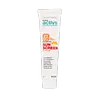What's inside
What's inside
 Key Ingredients
Key Ingredients

 Benefits
Benefits

No benefits
 Concerns
Concerns

 Ingredients Side-by-side
Ingredients Side-by-side

Water
Skin ConditioningHomosalate
Skin ConditioningEthylhexyl Salicylate
UV AbsorberPhenylbenzimidazole Sulfonic Acid
UV AbsorberOctocrylene
UV AbsorberButyl Methoxydibenzoylmethane
UV AbsorberBis-Ethylhexyloxyphenol Methoxyphenyl Triazine
Skin ConditioningMethyl Methacrylate Crosspolymer
Niacinamide
SmoothingUndecane
EmollientTriethanolamine
BufferingPropanediol
SolventPotassium Cetyl Phosphate
EmulsifyingDibutyl Adipate
EmollientNeopentyl Glycol Dicaprylate/Dicaprate
EmollientEthylhexyl Triazone
UV AbsorberDiethylamino Hydroxybenzoyl Hexyl Benzoate
UV FilterLauryl Methacrylate
Tridecane
PerfumingGlyceryl Stearate
EmollientDimethicone
EmollientPhenoxyethanol
PreservativeAminomethyl Propanol
BufferingParfum
MaskingStyrene/Acrylates/Ammonium Methacrylate Copolymer
Trimethylsiloxysilicate
EmollientPanthenol
Skin ConditioningBenzyl Alcohol
PerfumingCarnosine
Skin ConditioningAcacia Senegal Gum
MaskingAcrylates/C10-30 Alkyl Acrylate Crosspolymer
Emulsion StabilisingXanthan Gum
EmulsifyingCapryloyl Glycine
CleansingBisabolol
MaskingHexylene Glycol
EmulsifyingSodium Gluconate
Skin ConditioningGlycerin
HumectantSarcosine
Skin ConditioningButylene Glycol
HumectantCinnamomum Zeylanicum Bark Extract
AntimicrobialSodium PPG-16/PEG-2 Lauryl Ether Sulfate
EmulsifyingCaprylyl Glycol
EmollientPEG-4-PPG-7 C13/C15 Alcohol
Moringa Oleifera Seed Extract
Skin ConditioningPotassium Sorbate
PreservativeTetrasodium EDTA
Disodium Phosphate
BufferingCitric Acid
BufferingTocopherol
AntioxidantBenzyl Salicylate
PerfumingHexyl Cinnamal
PerfumingWater, Homosalate, Ethylhexyl Salicylate, Phenylbenzimidazole Sulfonic Acid, Octocrylene, Butyl Methoxydibenzoylmethane, Bis-Ethylhexyloxyphenol Methoxyphenyl Triazine, Methyl Methacrylate Crosspolymer, Niacinamide, Undecane, Triethanolamine, Propanediol, Potassium Cetyl Phosphate, Dibutyl Adipate, Neopentyl Glycol Dicaprylate/Dicaprate, Ethylhexyl Triazone, Diethylamino Hydroxybenzoyl Hexyl Benzoate, Lauryl Methacrylate, Tridecane, Glyceryl Stearate, Dimethicone, Phenoxyethanol, Aminomethyl Propanol, Parfum, Styrene/Acrylates/Ammonium Methacrylate Copolymer, Trimethylsiloxysilicate, Panthenol, Benzyl Alcohol, Carnosine, Acacia Senegal Gum, Acrylates/C10-30 Alkyl Acrylate Crosspolymer, Xanthan Gum, Capryloyl Glycine, Bisabolol, Hexylene Glycol, Sodium Gluconate, Glycerin, Sarcosine, Butylene Glycol, Cinnamomum Zeylanicum Bark Extract, Sodium PPG-16/PEG-2 Lauryl Ether Sulfate, Caprylyl Glycol, PEG-4-PPG-7 C13/C15 Alcohol, Moringa Oleifera Seed Extract, Potassium Sorbate, Tetrasodium EDTA, Disodium Phosphate, Citric Acid, Tocopherol, Benzyl Salicylate, Hexyl Cinnamal
Water
Skin ConditioningCyclopentasiloxane
EmollientC12-15 Alkyl Benzoate
AntimicrobialEthylhexyl Methoxycinnamate
UV AbsorberArachidyl Alcohol
EmollientBehenyl Alcohol
EmollientArachidyl Glucoside
EmulsifyingCetearyl Alcohol
EmollientDicetyl Phosphate
EmulsifyingCeteth-10 Phosphate
CleansingTitanium Dioxide
Cosmetic ColorantAluminum Hydroxide
EmollientStearic Acid
CleansingGlyceryl Stearate Se
EmulsifyingVp/Eicosene Copolymer
Polysorbate 20
EmulsifyingButyl Methoxydibenzoylmethane
UV AbsorberBis-Ethylhexyloxyphenol Methoxyphenyl Triazine
Skin ConditioningPhenoxyethanol
PreservativeEthylhexylglycerin
Skin ConditioningTocopheryl Acetate
AntioxidantDisodium EDTA
Water, Cyclopentasiloxane, C12-15 Alkyl Benzoate, Ethylhexyl Methoxycinnamate, Arachidyl Alcohol, Behenyl Alcohol, Arachidyl Glucoside, Cetearyl Alcohol, Dicetyl Phosphate, Ceteth-10 Phosphate, Titanium Dioxide, Aluminum Hydroxide, Stearic Acid, Glyceryl Stearate Se, Vp/Eicosene Copolymer, Polysorbate 20, Butyl Methoxydibenzoylmethane, Bis-Ethylhexyloxyphenol Methoxyphenyl Triazine, Phenoxyethanol, Ethylhexylglycerin, Tocopheryl Acetate, Disodium EDTA
Ingredients Explained
These ingredients are found in both products.
Ingredients higher up in an ingredient list are typically present in a larger amount.
You might know this ingredient as Tinosorb S or Bemotrizinol. It is a UV filter that covers both UVA and UVB rays.
This ingredient has two peak UV absorption peaks ( 310 and 340 nm) and is able to absorb both UV-A and UV-B rays. This ingredient works by preventing UV rays from reaching and damaging your skin.
On top of that - it is highly photostable and helps prevent the photodegration of other sunscreen ingredients such as avobenzone.
Tinosorb S is allowed in the EU, Australia, and Asia. It is close to being approved by the FDA and we'll hopefully get this ingredient in the U.S. by late 2025.
Fun fact: Tinosorb S is the most effective UV absorber at maximum concentration (measured by SPF) permitted in the EU.
This ingredient is oil-soluble, so your oil-cleansers will take this right off at night.
Learn more about Bis-Ethylhexyloxyphenol Methoxyphenyl TriazineAlso known as Avobenzone, this ingredient is a chemical sunscreen filter that provides protection in the UV-A range.
Avobenzone is globally approved and is the most commonly used UV-A filter in the world.
Studies have found that avobenzone becomes ineffective when exposed to UV light (it is not photostable; meaning that it breaks down in sunlight). Because of this, formulations that include avobenzone will usually contain stabilizers such as octocrylene.
However, some modern formulations (looking at you, EU!) are able to stabilize avobenzone by coating the molecules.
Avobenzone does not protect against the UV-B range, so it's important to check that the sunscreen you're using contains other UV filters that do!
The highest concentration of avobenzone permitted is 3% in the US, and 5% in the EU.
Learn more about Butyl MethoxydibenzoylmethanePhenoxyethanol is a preservative that has germicide, antimicrobial, and aromatic properties. Studies show that phenoxyethanol can prevent microbial growth. By itself, it has a scent that is similar to that of a rose.
It's often used in formulations along with Caprylyl Glycol to preserve the shelf life of products.
Water. It's the most common cosmetic ingredient of all. You'll usually see it at the top of ingredient lists, meaning that it makes up the largest part of the product.
So why is it so popular? Water most often acts as a solvent - this means that it helps dissolve other ingredients into the formulation.
You'll also recognize water as that liquid we all need to stay alive. If you see this, drink a glass of water. Stay hydrated!
Learn more about Water